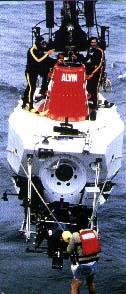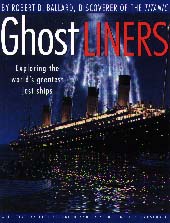|
________________
CM . . . .
Volume V Number 20 . . . . June 4, 1999
excerpt: Like those tiny figures of the doomed Titanic, the people who lived and died on these ships still seem incredibly distant, inhabitants of a lost world. One way of getting closer to them is to put ourselves in their places and to imagine how we would have behaved as our huge and powerful ship that had seemed so safe began to sink. If I had been a young boy traveling third class on the Titanic, like Willie Coutts, would I have panicked-- or somehow reached safety? If I had been a Sea Scout on the Britannic, like James Vickers, would I have jumped into the first lifeboat or stayed until the ship was about to sink? If I had been asleep on one ship and awakened on another-- like Linda Morgan on the Andrea Doria -- how would it have affected the way I lived the rest of my life?  Those who put too much faith in technology will one day regret their
decision. They would do better to put their trust in people. So say the
authors of this magnificent book which takes readers on a deep-sea
expedition to view a number of famous sunken ships-- the Titanic,
the Lusitania, the Empress of Ireland, the Andrea
Doria and the Britannic, Titanic's giant sister ship.
For one reason or other-- superior design, added safety features, a
state-of-the-art radar system, or, as in the case of the Britannic,
its use as a hospital ship, and, therefore, considered to be immune from
enemy attack--these ships were once thought to be unsinkable, yet now they
lie at the bottom of the sea, their hulls overgrown with coral and
barnacles. Ballard, discoverer of the Titanic, along with author
Archbold, gives readers a guided tour of the ships as they were on their
inaugural voyages, resplendent in decor and furnishings, and as they are
today, eerie, quiet, underwater graveyards. He attempts to find answers to
such questions as what actually sank the Britannic and was the
Lusitania, torpedoed by the Germans in 1915, carrying weapons for
the British?
Those who put too much faith in technology will one day regret their
decision. They would do better to put their trust in people. So say the
authors of this magnificent book which takes readers on a deep-sea
expedition to view a number of famous sunken ships-- the Titanic,
the Lusitania, the Empress of Ireland, the Andrea
Doria and the Britannic, Titanic's giant sister ship.
For one reason or other-- superior design, added safety features, a
state-of-the-art radar system, or, as in the case of the Britannic,
its use as a hospital ship, and, therefore, considered to be immune from
enemy attack--these ships were once thought to be unsinkable, yet now they
lie at the bottom of the sea, their hulls overgrown with coral and
barnacles. Ballard, discoverer of the Titanic, along with author
Archbold, gives readers a guided tour of the ships as they were on their
inaugural voyages, resplendent in decor and furnishings, and as they are
today, eerie, quiet, underwater graveyards. He attempts to find answers to
such questions as what actually sank the Britannic and was the
Lusitania, torpedoed by the Germans in 1915, carrying weapons for
the British?
Archbold's vivid descriptions help readers to see the pea-soup fog that contributed to the demise of the Andrea Doria and to feel Robert Ballard's sense of excitement and awe when he first came upon the wreck of the Titanic. Personal anecdotes serve to recreate, through the eyes of some of the survivors, the events of the fateful nights on which the ghost liners sank and to underscore the tragedy of the many lives lost. The riveting text is superbly complemented by abundant underwater photographs, archival images (including photos, postcards and newspaper articles) and Marschall's stunning paintings which are so realistic, they virtually leap-- or, in this case, sail-- off the pages. A glossary and a list of recommended reading are provided. With the interest created by last year's box office mega-hit, Titanic, this book is sure to be popular with all ages. A fascinating look at the haunting liners that once graced the waters of the Atlantic. Highly Recommended. Gail Hamilton is a teacher-librarian at Bird's Hill School in East St. Paul, MB.
To comment on this title or this review, send mail to cm@umanitoba.ca.
Copyright © the Manitoba Library Association.
Reproduction for personal use is permitted only if this copyright notice
is maintained. Any other reproduction is prohibited without
permission.
Published by
TABLE OF CONTENTS FOR THIS ISSUE - JUNE 4,
1999.
AUTHORS |
TITLES |
MEDIA REVIEWS |
PROFILES |
BACK ISSUES |
SEARCH |
CMARCHIVE |
HOME
|

